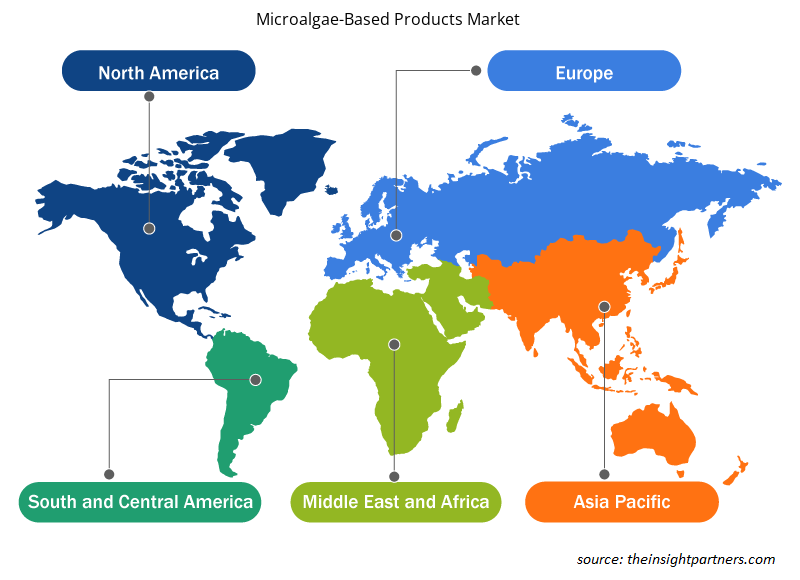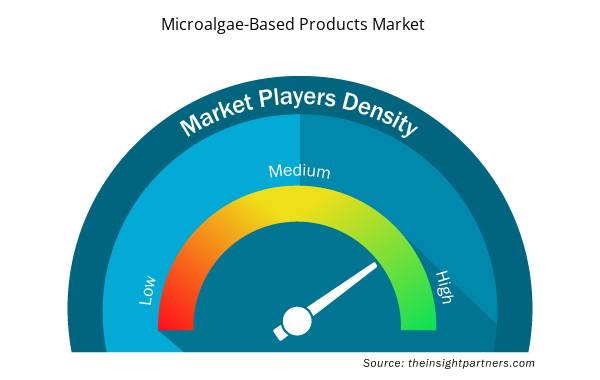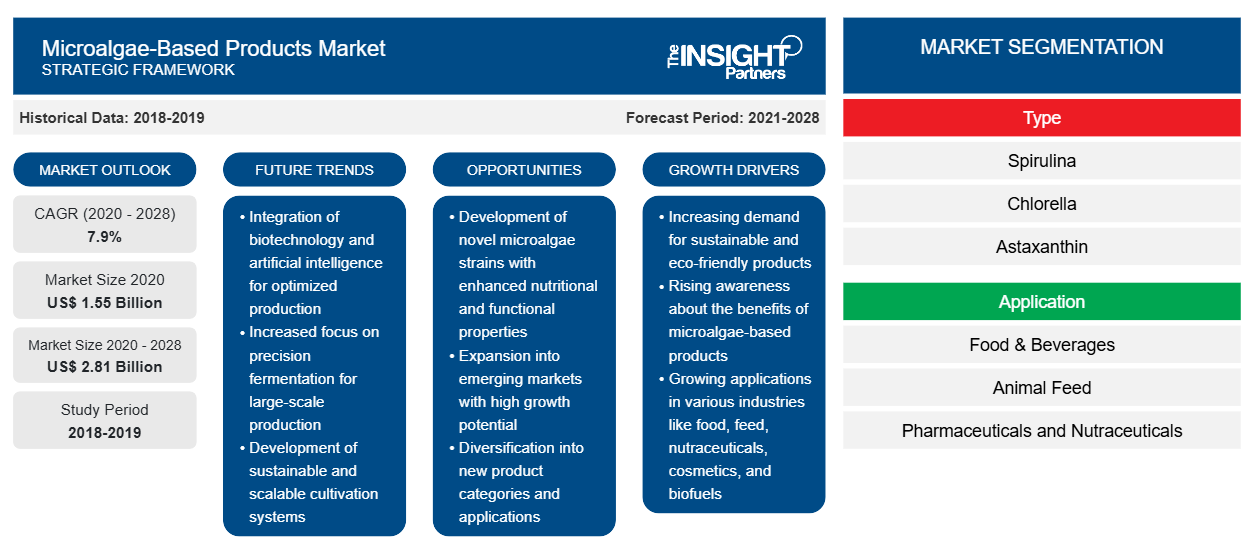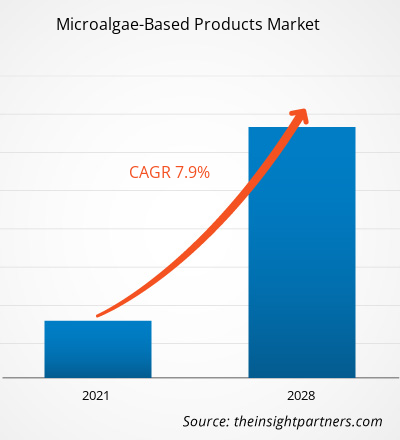Der Markt für Produkte auf Basis von Mikroalgen hatte im Jahr 2020 einen Wert von 1.547,23 Millionen US-Dollar und soll bis 2028 einen Wert von 2.811,10 Millionen US-Dollar erreichen; von 2021 bis 2028 wird mit einer durchschnittlichen jährlichen Wachstumsrate von 7,9 % gerechnet.
Mikroalgen sind prokaryotische oder eukaryotische Mikroorganismen, die mithilfe eines Mikroskops aufgespürt werden können. Diese mikroskopischen Organismen sind einzellige Arten, die einzeln oder in Ketten oder Gruppen vorkommen und in Süßwasser- und Meeressystemen vorkommen. Diese Mikroorganismen haben eine einfache Zellstruktur und benötigen für ihr Wachstum Licht, Kohlendioxid, Wasser und wichtige Nährstoffe wie Phosphor und Stickstoff. Außerdem sind Mikroalgen eine Quelle lebenswichtiger sekundärer Pflanzenstoffe wie Carotinoide , Ballaststoffe, Mineralien, Antioxidantien, Fettsäuren, Vitamine, halogenierte Verbindungen, Polysaccharide , Proteine und Lektine . Mikroalgen gelten als wertvolle Biomassequelle mit vielfältigem Potenzial in zahlreichen Branchen. Mikroalgen finden beispielsweise Anwendung in unterschiedlichen Endverbrauchsbranchen wie der Lebensmittel- und Getränkeindustrie, Tierernährung, Pharmazeutika und Nutraceutika sowie Körperpflege.
Im Jahr 2020 hatte Europa den größten Anteil am globalen Markt für mikroalgenbasierte Produkte . Die Dominanz des Marktes für mikroalgenbasierte Produkte in dieser Region ist in erster Linie auf das Vorhandensein einer starken industriellen Basis mit namhaften Herstellern von Arzneimitteln und Nutraceutika sowie verpackten Lebensmitteln und Getränken zurückzuführen. Die hohe Nachfrage nach mikroalgenbasierten Produkten aus verschiedenen Anwendungsbereichen wie Lebensmitteln und Getränken, Tierfutter, Arzneimitteln und Nutraceutika , Körperpflege, Chemikalien und Biokraftstoffen fördert das Marktwachstum in Europa. Steigende Investitionen in Anbautechnologien sowie ein zunehmender Fokus auf nachhaltige Lösungen bieten lukrative Möglichkeiten für das Wachstum des Marktes für mikroalgenbasierte Produkte in der Region.
Passen Sie diesen Bericht Ihren Anforderungen an
Sie erhalten kostenlose Anpassungen an jedem Bericht, einschließlich Teilen dieses Berichts oder einer Analyse auf Länderebene, eines Excel-Datenpakets sowie tolle Angebote und Rabatte für Start-ups und Universitäten.
- Holen Sie sich die wichtigsten Markttrends aus diesem Bericht.Dieses KOSTENLOSE Beispiel umfasst eine Datenanalyse von Markttrends bis hin zu Schätzungen und Prognosen.
Auswirkungen der COVID-19-Pandemie auf den Markt für mikroalgenbasierte Produkte
Die anhaltende Pandemie hat den Status des Lebensmittel- und Getränkesektors drastisch verändert und sich negativ auf das Wachstum des Marktes für Produkte auf Mikroalgenbasis ausgewirkt . Die Umsetzung von Maßnahmen zur Bekämpfung der Ausbreitung des Virus hat die Situation verschärft und das Wachstum mehrerer Industriezweige beeinträchtigt. Der Markt wurde durch die plötzliche Verzerrung der Betriebseffizienz und Störungen der Wertschöpfungsketten beeinflusst, die auf die plötzliche Schließung nationaler und internationaler Grenzen zurückzuführen sind. Störungen bei der Beschaffung von Rohstoffen von Lieferanten und vorübergehende Schließungen von Produktionsstandorten aufgrund unbefristeter Sperrungen und Reisebeschränkungen haben das Wachstum des Marktes während der Pandemie beeinträchtigt. So sehr die Pandemie jedoch die Abläufe der Lieferketten beeinträchtigt hat, hat sie auch den Fokus der Verbraucher auf eine gesunde Lebensweise verlagert, wodurch die Verbraucher ihre Aufmerksamkeit auf nahrhafte Lebensmittel gerichtet haben. Darüber hinaus wird erwartet, dass die steigende Nachfrage nach Produkten auf Mikroalgenbasis in den Bereichen Lebensmittel und Getränke, Pharmazeutika und Nutrazeutika , Tierfutter und anderen Branchen sowie erhebliche Investitionen namhafter Hersteller den Markt für Produkte auf Mikroalgenbasis ankurbeln werden. Darüber hinaus wurden mehrere Anwendungen von Mikroalgen bei der Behandlung der COVID-19-Pandemie identifiziert. Eine im November 2020 von Frontiers Media SA veröffentlichte Studie zeigt beispielsweise die Wirksamkeit von aus Mikroalgen gewonnenen bioaktiven Metaboliten bei der Behandlung einer SARS-CoV-2-ähnlichen Virusinfektion.
Markteinblicke
Steigende Nachfrage nach Mikroalgen in pharmazeutischen und nutraceutischen Anwendungen
Produkte auf Basis von Mikroalgen haben den allgemein als sicher anerkannten ( GRAS ) Status erhalten, wodurch sie für pharmazeutische und nutraceutische Anwendungen geeignet sind. Mikroalgen sind für ihre antibakterielle, antioxidative, antivirale, antimalaria-, antimykotische , antitumorale und entzündungshemmende Wirkung bekannt. Sie sind eine Quelle lebenswichtiger sekundärer Pflanzenstoffe wie Carotinoide , Ballaststoffe, Mineralien, Antioxidantien, Fettsäuren, Vitamine, halogenierte Verbindungen, Polysaccharide sowie Lektine und andere Proteine. So sind die in Mikroalgen enthaltenen mehrfach ungesättigten Fettsäuren ( PUFA ) potenzielle Therapeutika, die auch das Risiko chronischer Erkrankungen wie Herz-Kreislauf-Erkrankungen, Diabetes, Alzheimer und Netzhautproblemen minimieren. Ebenso werden Cyanobakterien (Blaualgen) zunehmend bei der Synthese von Antibiotika und pharmakologisch aktiven Verbindungen eingesetzt. Ebenso wurde die Verwendung von Cyanobakterien (Blaualgen) auf die Herstellung von Antibiotika und pharmakologisch aktiven Verbindungen ausgeweitet. Mehrere Forschungsstudien betonen auch die Bedeutung der Einnahme von Chlorella -Tabletten bei der Behandlung von Übelkeit, Erbrechen und anderen Magen-Darm-Problemen. Ebenso hilft Carrageen aus Rotalgen bei der Behandlung des Grippevirus. Algen gelten auch als wichtige Quelle für pharmakologisch aktive Naturprodukte und Nutraceuticals . Die aus verschiedenen Algenvarianten gewonnenen Naturprodukte dienen als Grundlage für die Arzneimittelentdeckung und finden Anwendung bei der Formulierung von Medikamenten. Die potenzielle Anwendung von Mikroalgen wurde auch in der Nutraceutical- Industrie festgestellt. Derzeit ist der Wert von Nutraceuticals, die aus Algenbiomasse gewonnen werden, auf dem Markt sehr hoch. Mikroalgen können in erheblichem Maße bei der Herstellung von Nahrungsergänzungsmitteln, diätetischen Ergänzungsmitteln und höherwertigen verarbeiteten Lebensmitteln sowie Nicht-Nahrungsergänzungsmitteln wie Tabletten und Weichkapseln verwendet werden. Beispielsweise werden Mikroalgen aus Chlorella , Dunaliella , Haematococcus , Spirulina und Aphanizomenon häufig zur Herstellung von Nahrungsergänzungsmitteln verwendet. Daher steigt die Nachfrage nach Mikroalgen in der Pharma- undAnwendungsgrundlagen für Nutraceuticals .
Typ-Einblicke
Je nach Typ ist der Markt für Produkte auf Basis von Mikroalgen in Spirulina , Chlorella , Astaxanthin , Beta-Carotin und andere unterteilt. Im Jahr 2020 dominierte das Spirulina -Segment den globalen Markt für Produkte auf Basis von Mikroalgen . Spirulina ist definiert als prokaryotisches Cyanobakterium , das für vielfältige Anwendungsbereiche wie Aquakultur, Pharmazeutika und Nutraceutika sowie Lebensmittelfarben hergestellt wird. Die Mikroalgen bestehen zu 60–70 % aus Proteinen, darunter Aminosäuren wie Leucin, Isoleucin und Valin , sowie anderen essentiellen Mineralstoffen wie Beta-Carotin, B-Vitaminen, Phycocyanin , Chlorophyll und Vitamin E. Das Nährwertprofil der Algen macht sie zu einer idealen Zutat für verschiedene Anwendungsbereiche. Spirulina- Algen gelten als Superfood und werden in großem Umfang gezüchtet, um die steigende Nachfrage in diversen Endverbrauchsbranchen zu decken.
Anwendungseinblicke
Basierend auf der Anwendung ist der Markt für Produkte auf Mikroalgenbasis in Lebensmittel und Getränke, Tierfutter, Arzneimittel und Nutraceutika, Körperpflege und andere unterteilt. Das Segment Arzneimittel und Nutraceutika hatte im Jahr 2020 den größten Marktanteil. Mikroalgen gelten als eine der erneuerbaren Quellen für pharmazeutische Verbindungen und werden als allgemein als sicher anerkannte (GRAS) Verbindungen eingestuft, die sich ideal für den Einsatz in der Pharmaindustrie eignen. Mikroalgen werden in erheblichem Maße bei der Formulierung von Krebsmedikamenten verwendet – einer Verbindung namens Cryptophyci. Darüber hinaus werden sie aufgrund ihrer entzündungshemmenden und krebshemmenden Eigenschaften auch zur Herstellung alkaloidaler Neurotoxine wie Saxitoxin und Polyketid verwendet. In ähnlicher Weise werden Mikroalgen wie Chlorella, Dunaliella, Haematococcus, Spirulina und Aphanizomenon häufig bei der Formulierung von Nahrungsergänzungsmitteln verwendet.
Zu den wichtigsten Akteuren auf dem Markt für mikroalgenbasierte Produkte gehören Algae Health Sciences – ein BGG-Unternehmen; Cargill Inc.; Cellana Inc.; und Cyanotech Corporation. Die wichtigsten Unternehmen führen Fusionen und Übernahmen sowie F&E-Strategien durch, um ihren Kundenstamm zu erweitern und Marktanteile auf dem globalen Markt für mikroalgenbasierte Produkte zu gewinnen, was ihnen ermöglichen würde, die Reichweite ihres Markennamens zu erhöhen.
Bericht-Spotlights
- Fortschrittliche Branchentrends auf dem Markt für Mikroalgenprodukte helfen den Akteuren bei der Entwicklung wirksamer langfristiger Strategien
- In Industrie- und Entwicklungsländern angewandte Strategien für Unternehmenswachstum
- Quantitative Analyse des Marktes für Mikroalgenprodukte von 2019 bis 2028
- Schätzung der weltweiten Nachfrage nach Mikroalgenprodukten
- PEST-Analyse zur Veranschaulichung der Wirksamkeit der in der Branche tätigen Käufer und Lieferanten
- Aktuelle Entwicklungen zum Verständnis des wettbewerbsorientierten Marktszenarios
- Markttrends und -aussichten sowie Faktoren, die das Wachstum des Marktes für Mikroalgenprodukte vorantreiben und bremsen
- Unterstützung im Entscheidungsprozess durch Aufzeigen von Marktstrategien, die das kommerzielle Interesse untermauern und zum Marktwachstum führen
- Größe des Marktes für Mikroalgenprodukte an verschiedenen Knotenpunkten
- Detaillierte Übersicht und Segmentierung des Marktes sowie der Dynamik der Mikroalgen-basierten Produkte
- Größe des Marktes für Mikroalgenprodukte in verschiedenen Regionen mit vielversprechenden Wachstumschancen
Auf der Grundlage des Typs wurde der globale Markt für Produkte auf Mikroalgenbasis in Spirulina, Chlorella, Astaxanthin, Beta-Carotin und andere unterteilt.
Auf Grundlage der Anwendung wurde der globale Markt für Produkte auf Mikroalgenbasis in die Bereiche Nahrungsmittel und Getränke, Tierfutter, Pharmazeutika und Nutraceutika, Körperpflege und Sonstiges segmentiert.
Regionale Einblicke in den Markt für Produkte auf Mikroalgenbasis
Die regionalen Trends und Faktoren, die den Markt für mikroalgenbasierte Produkte während des gesamten Prognosezeitraums beeinflussen, wurden von den Analysten von Insight Partners ausführlich erläutert. In diesem Abschnitt werden auch die Marktsegmente und die Geografie für mikroalgenbasierte Produkte in Nordamerika, Europa, im asiatisch-pazifischen Raum, im Nahen Osten und Afrika sowie in Süd- und Mittelamerika erörtert.

- Erhalten Sie regionale Daten zum Markt für Mikroalgenprodukte
Umfang des Marktberichts zu Produkten auf Mikroalgenbasis
| Berichtsattribut | Details |
|---|---|
| Marktgröße im Jahr 2020 | 1,55 Milliarden US-Dollar |
| Marktgröße bis 2028 | 2,81 Milliarden US-Dollar |
| Globale CAGR (2020 - 2028) | 7,9 % |
| Historische Daten | 2018-2019 |
| Prognosezeitraum | 2021-2028 |
| Abgedeckte Segmente | Nach Typ
|
| Abgedeckte Regionen und Länder | Nordamerika
|
| Marktführer und wichtige Unternehmensprofile |
|
Dichte der Marktteilnehmer auf Mikroalgenbasis: Auswirkungen auf die Geschäftsdynamik verstehen
Der Markt für Produkte auf Mikroalgenbasis wächst rasant, angetrieben durch die steigende Nachfrage der Endverbraucher aufgrund von Faktoren wie sich entwickelnden Verbraucherpräferenzen, technologischen Fortschritten und einem größeren Bewusstsein für die Vorteile des Produkts. Mit steigender Nachfrage erweitern Unternehmen ihr Angebot, entwickeln Innovationen, um die Bedürfnisse der Verbraucher zu erfüllen, und nutzen neue Trends, was das Marktwachstum weiter ankurbelt.
Die Marktteilnehmerdichte bezieht sich auf die Verteilung der Firmen oder Unternehmen, die in einem bestimmten Markt oder einer bestimmten Branche tätig sind. Sie gibt an, wie viele Wettbewerber (Marktteilnehmer) in einem bestimmten Marktraum im Verhältnis zu seiner Größe oder seinem gesamten Marktwert präsent sind.
Die wichtigsten auf dem Markt für auf Mikroalgen basierende Produkte tätigen Unternehmen sind:
- Algae Health Sciences – Ein Unternehmen der BGG
- Astareal Ab
- Bluebiotech International Gmbh
- Cargill, Incorporated
- Cellana Inc.
Haftungsausschluss : Die oben aufgeführten Unternehmen sind nicht in einer bestimmten Reihenfolge aufgeführt.

- Erhalten Sie einen Überblick über die wichtigsten Akteure auf dem Markt für mikroalgenbasierte Produkte
Firmenprofile
- Algae Health Sciences – Ein Unternehmen der BGG
- Bluebiotech International Gmbh
- Cargill Inc
- Cellana Inc
- Earthrise Nutritionals, LLC
- EID - Parry (India) Limited
- Cyanotech Corporation
- Euglena Co., Ltd
- Far East Bio-Tec Co., Ltd
- AstaReal
- Historische Analyse (2 Jahre), Basisjahr, Prognose (7 Jahre) mit CAGR
- PEST- und SWOT-Analyse
- Marktgröße Wert/Volumen – Global, Regional, Land
- Branche und Wettbewerbsumfeld
- Excel-Datensatz


- Pipe Relining Market
- Sodium Bicarbonate Market
- Biopharmaceutical Contract Manufacturing Market
- Semiconductor Metrology and Inspection Market
- Automotive Fabric Market
- Third Party Logistics Market
- Vessel Monitoring System Market
- Electronic Toll Collection System Market
- Artificial Intelligence in Defense Market
- Oxy-fuel Combustion Technology Market

Report Coverage
Revenue forecast, Company Analysis, Industry landscape, Growth factors, and Trends

Segment Covered
This text is related
to segments covered.

Regional Scope
North America, Europe, Asia Pacific, Middle East & Africa, South & Central America

Country Scope
This text is related
to country scope.
Häufig gestellte Fragen
Microalgae-based products market are expected to witness significant growth in the coming years. Many countries across the globe are increasing their investments in the R&D of microalgae in order to explore the commercial viability of its various applications. Growing requirements to meet the food demand is another factor expected to influence the microalgae-based products market growth in the future. It provides much better yield with lower land requirements, in comparison to other food sources. Biofuels derived through microalgae are also witnessing interest from various parts of the world. Increasing awareness about the climate crisis has led to the rise in demand for cleaner sources of fuel, food as well as to reform the practices that have a negative impact on the environment. Such factors would aid the growth of the microalgae-based products market in the coming years.
Asia Pacific region accounts for a significant share of the global population and the rising disposable incomes and urbanization have increased the demand for new types of food products in the region. Moreover, the emerging economies such as China and India account for a very large share of the Spirulina production. Growing demand for vegan or vegetarian food, have positively contributed to the growth of the market. Moreover, pharmaceuticals and nutraceuticals have been witnessing a surge in demand in the region over the past few years.
Pharmaceutical and nutraceuticals accounted for a major share of the global demand for microalgae-based products in 2020. Increasing consumption of nutritional supplements has propelled the demand for microalgae-based products market. Busy lifestyles, increasing healthcare costs and the growing awareness of the individual daily nutritional requirement have all aided the growth of the pharmaceuticals and nutraceuticals segment of the global microalgae-based products market.
Spirulina accounted for a significant share of the global microalgae-based products market in 2020. Spirulina is a rich and clean source of protein and has gained significant demand over the last decade. In addition to this, it contains Vitamins B1, B2, B3, Copper and Iron. It is widely used for its antioxidant and anti-inflammatory properties while it also helps regulate cholesterol levels.
The major players operating in the global microalgae-based products market are Algae Health Sciences - A BGG company; Bluebiotech International Gmbh; Cargill, Incorporated; Cellana Inc.; Earthrise Nutritionals, LLC; E.I.D. - Parry (India) Limited; Cyanotech Corporation; Euglena Co., Ltd.; Far East Bio-Tec Co., Ltd; and AstaReal among many others.
Microalgae are unicellular microorganisms that live in saline or freshwater. They are a rich source of vital minerals and they are currently used in various applications such as food products, nutritional supplements, personal care, biofuels and others.
Based, on type, the microalgae-based products market is segmented into Spirulina, Chlorella, Astaxanthin, Beta Carotene, and others. Based on application, the global microalgae-based products market is segmented into food & beverages, animal feed, pharmaceuticals and nutraceuticals, personal care, and others.
Trends and growth analysis reports related to Food and Beverages : READ MORE..
The List of Companies - Microalgae-based Product Market
- Algae Health Sciences - A Bgg Company
- Astareal Ab
- Bluebiotech International Gmbh
- Cargill, Incorporated
- Cellana Inc.
- Cyanotech Corporation
- Earthrise Nutritionals, Llc
- Eid Parry Ltd.
- Euglena Co, Ltd
- Far East Bio-Tec Co., Ltd
The Insight Partners performs research in 4 major stages: Data Collection & Secondary Research, Primary Research, Data Analysis and Data Triangulation & Final Review.
- Data Collection and Secondary Research:
As a market research and consulting firm operating from a decade, we have published and advised several client across the globe. First step for any study will start with an assessment of currently available data and insights from existing reports. Further, historical and current market information is collected from Investor Presentations, Annual Reports, SEC Filings, etc., and other information related to company’s performance and market positioning are gathered from Paid Databases (Factiva, Hoovers, and Reuters) and various other publications available in public domain.
Several associations trade associates, technical forums, institutes, societies and organization are accessed to gain technical as well as market related insights through their publications such as research papers, blogs and press releases related to the studies are referred to get cues about the market. Further, white papers, journals, magazines, and other news articles published in last 3 years are scrutinized and analyzed to understand the current market trends.
- Primary Research:
The primarily interview analysis comprise of data obtained from industry participants interview and answers to survey questions gathered by in-house primary team.
For primary research, interviews are conducted with industry experts/CEOs/Marketing Managers/VPs/Subject Matter Experts from both demand and supply side to get a 360-degree view of the market. The primary team conducts several interviews based on the complexity of the markets to understand the various market trends and dynamics which makes research more credible and precise.
A typical research interview fulfils the following functions:
- Provides first-hand information on the market size, market trends, growth trends, competitive landscape, and outlook
- Validates and strengthens in-house secondary research findings
- Develops the analysis team’s expertise and market understanding
Primary research involves email interactions and telephone interviews for each market, category, segment, and sub-segment across geographies. The participants who typically take part in such a process include, but are not limited to:
- Industry participants: VPs, business development managers, market intelligence managers and national sales managers
- Outside experts: Valuation experts, research analysts and key opinion leaders specializing in the electronics and semiconductor industry.
Below is the breakup of our primary respondents by company, designation, and region:

Once we receive the confirmation from primary research sources or primary respondents, we finalize the base year market estimation and forecast the data as per the macroeconomic and microeconomic factors assessed during data collection.
- Data Analysis:
Once data is validated through both secondary as well as primary respondents, we finalize the market estimations by hypothesis formulation and factor analysis at regional and country level.
- Macro-Economic Factor Analysis:
We analyse macroeconomic indicators such the gross domestic product (GDP), increase in the demand for goods and services across industries, technological advancement, regional economic growth, governmental policies, the influence of COVID-19, PEST analysis, and other aspects. This analysis aids in setting benchmarks for various nations/regions and approximating market splits. Additionally, the general trend of the aforementioned components aid in determining the market's development possibilities.
- Country Level Data:
Various factors that are especially aligned to the country are taken into account to determine the market size for a certain area and country, including the presence of vendors, such as headquarters and offices, the country's GDP, demand patterns, and industry growth. To comprehend the market dynamics for the nation, a number of growth variables, inhibitors, application areas, and current market trends are researched. The aforementioned elements aid in determining the country's overall market's growth potential.
- Company Profile:
The “Table of Contents” is formulated by listing and analyzing more than 25 - 30 companies operating in the market ecosystem across geographies. However, we profile only 10 companies as a standard practice in our syndicate reports. These 10 companies comprise leading, emerging, and regional players. Nonetheless, our analysis is not restricted to the 10 listed companies, we also analyze other companies present in the market to develop a holistic view and understand the prevailing trends. The “Company Profiles” section in the report covers key facts, business description, products & services, financial information, SWOT analysis, and key developments. The financial information presented is extracted from the annual reports and official documents of the publicly listed companies. Upon collecting the information for the sections of respective companies, we verify them via various primary sources and then compile the data in respective company profiles. The company level information helps us in deriving the base number as well as in forecasting the market size.
- Developing Base Number:
Aggregation of sales statistics (2020-2022) and macro-economic factor, and other secondary and primary research insights are utilized to arrive at base number and related market shares for 2022. The data gaps are identified in this step and relevant market data is analyzed, collected from paid primary interviews or databases. On finalizing the base year market size, forecasts are developed on the basis of macro-economic, industry and market growth factors and company level analysis.
- Data Triangulation and Final Review:
The market findings and base year market size calculations are validated from supply as well as demand side. Demand side validations are based on macro-economic factor analysis and benchmarks for respective regions and countries. In case of supply side validations, revenues of major companies are estimated (in case not available) based on industry benchmark, approximate number of employees, product portfolio, and primary interviews revenues are gathered. Further revenue from target product/service segment is assessed to avoid overshooting of market statistics. In case of heavy deviations between supply and demand side values, all thes steps are repeated to achieve synchronization.
We follow an iterative model, wherein we share our research findings with Subject Matter Experts (SME’s) and Key Opinion Leaders (KOLs) until consensus view of the market is not formulated – this model negates any drastic deviation in the opinions of experts. Only validated and universally acceptable research findings are quoted in our reports.
We have important check points that we use to validate our research findings – which we call – data triangulation, where we validate the information, we generate from secondary sources with primary interviews and then we re-validate with our internal data bases and Subject matter experts. This comprehensive model enables us to deliver high quality, reliable data in shortest possible time.


 Holen Sie sich ein kostenloses Muster für diesen Bericht
Holen Sie sich ein kostenloses Muster für diesen Bericht